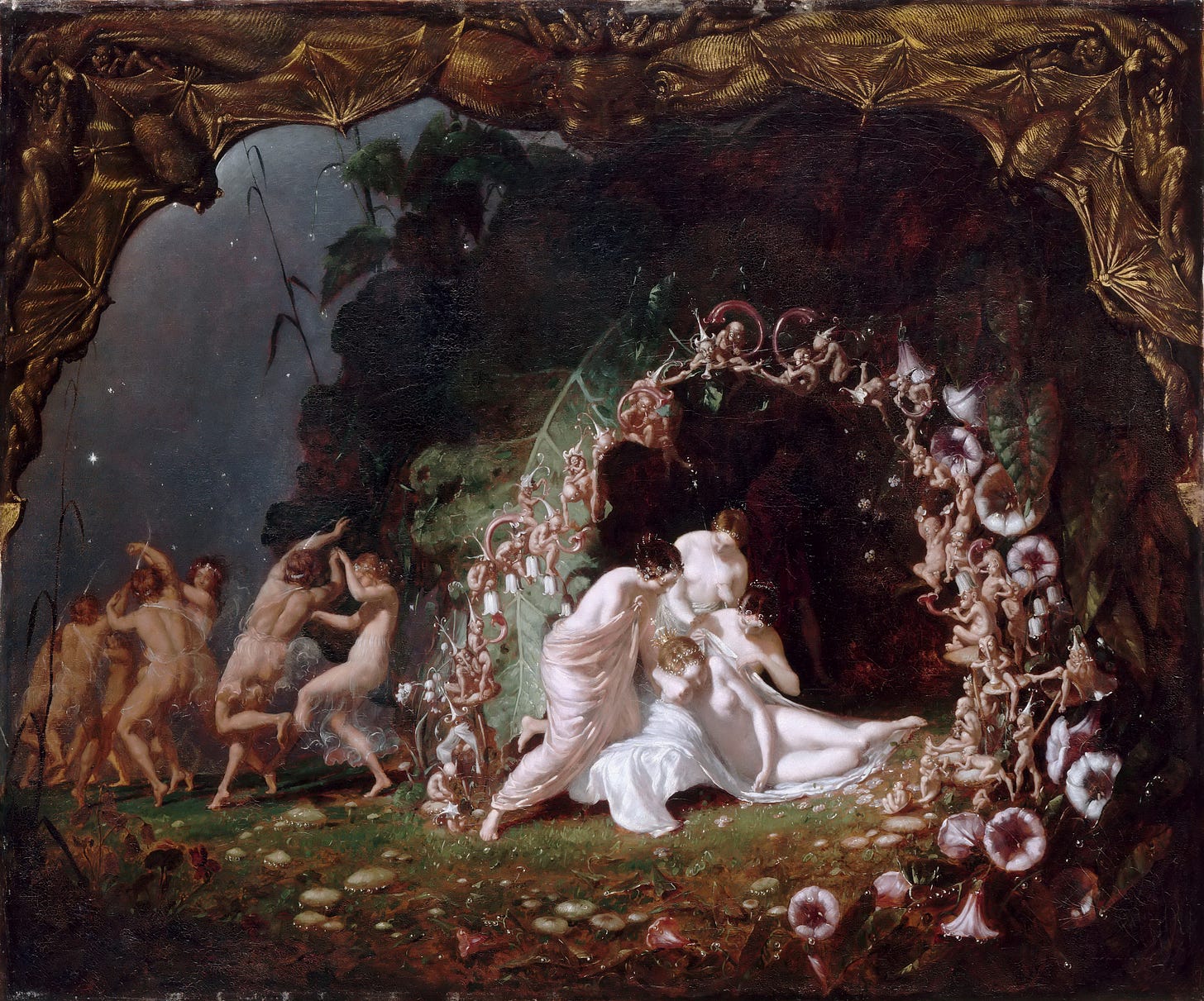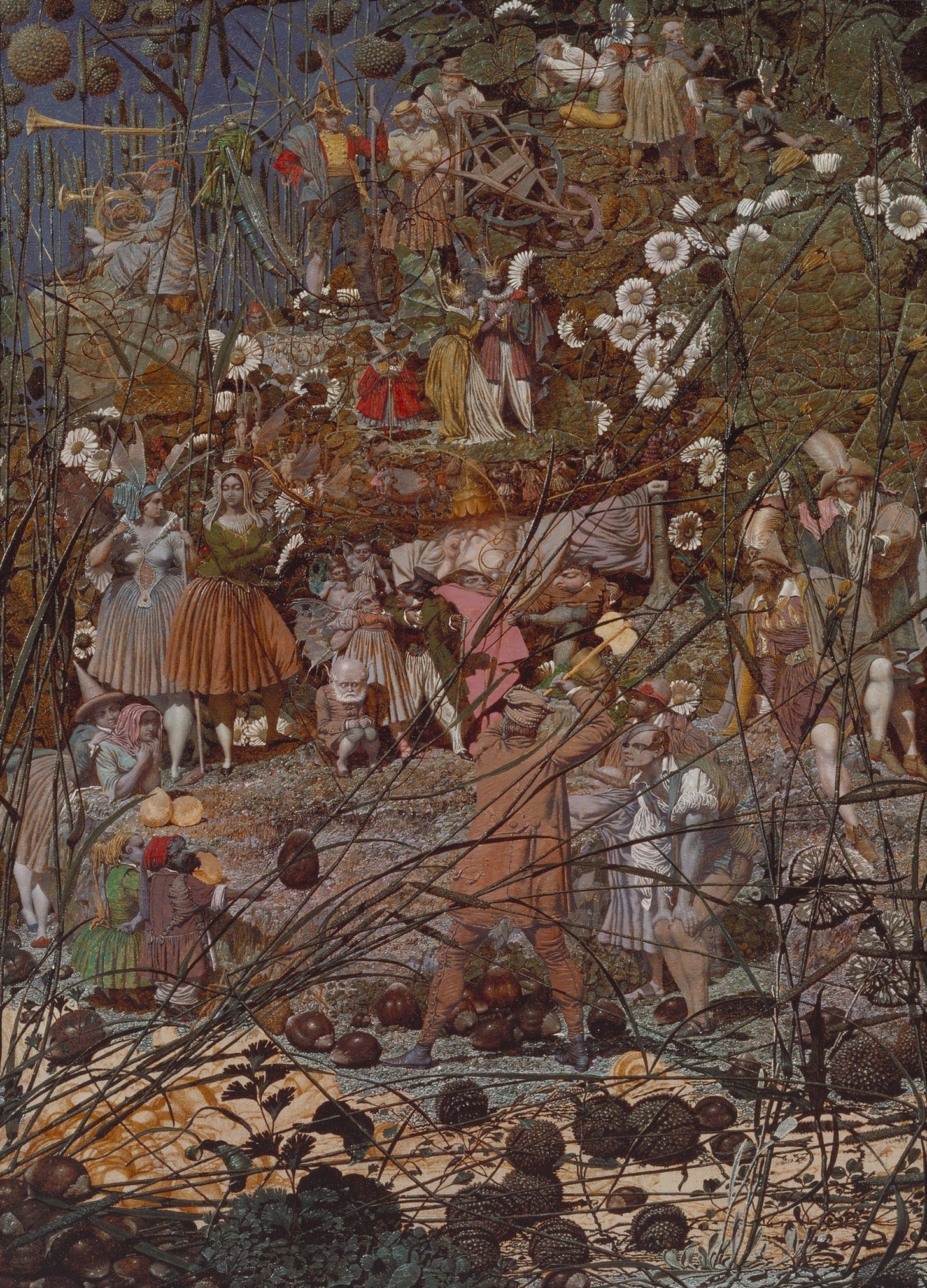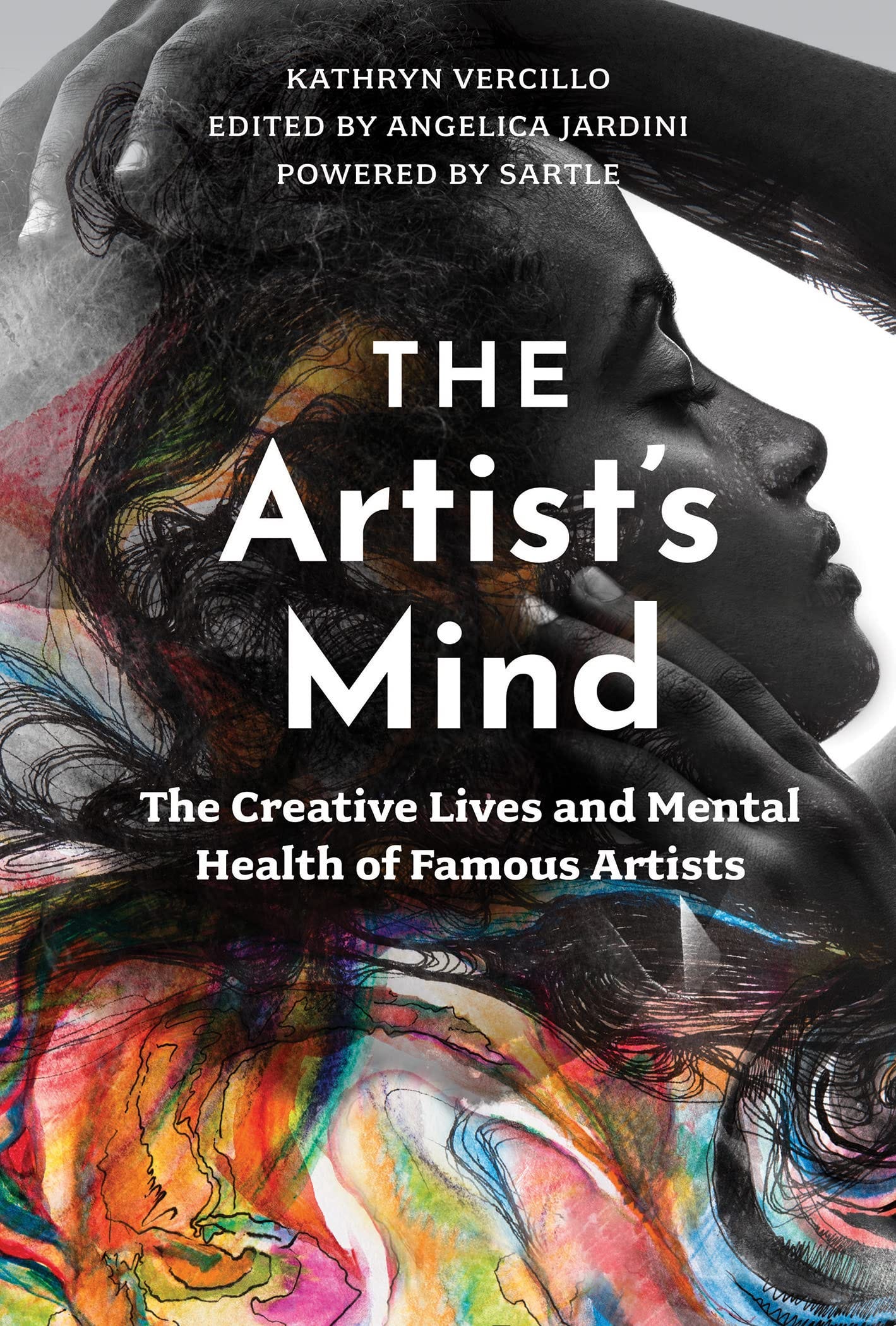Today we have an excerpt from The Artist's Mind: The Creative Lives and Mental Health of Famous Artists by
. In this book, Kathryn shares the biographies, work, and mental health history of famous visual artists, posing questions about what the relationship between art and mental health is for each person. Instead of answering the question, she begins a conversation about how mental health challenges impact each artist’s creative content, process, and career. In this excerpt, she shares a little of painter and poet Richard Dadd’s story (with a few references to a chapter on Leonora Carrington thrown in.)Richard Dadd
(August 1, 1817 - January 7, 1886)
In his mid-twenties, Richard Dadd took a trip that precipitated a lifetime journey of mental illness and simultaneously set the tone for most of what he would paint in the decades to come1. Dadd had shown budding promise as an artist and began studying at London’s Royal Academy of Arts2. He had some success with his first paintings, which were of fairies. In particular Puck and Titania Sleeping were well-received3. At 26, he was commissioned by Sir Thomas Phillips to take a long trip together and for the artist to draw what he saw during that trek4. During the ten-month expedition, Dadd grew increasingly angry with others, began to have delusions, and threatened to murder the Pope5. After visiting Syria, Dadd wrote a letter to a friend in which he said his imagination was “so full of vagaries” that he doubted his own sanity.6 Their travels proceeded to the Holy Land in the Middle East and the Nile River in Africa, after which Dadd wrote that he had nearly a week of nervous depression which he himself couldn’t understand. His mental breakdown in and around Egypt would go on to inform his thoughts, and his art, for the rest of his life.
When Dadd returned home to England, the delusions overtook him; his behavior changed, his diet got weird (“he lived for some time on nothing but ale and eggs”), and people had difficulty understanding him when he talked.7 The strange diet and delusions that didn’t make sense to others were similar to those of Leonora Carrington when she had her traumatic breakdown. A doctor diagnosed Dadd with “an aberration of the intellect” and recommended psychiatric care, but his father declined to get him professional help. That was a mistake for Richard but even more so for his father; during a walk in the park, Richard murdered his father by stabbing him in the chest and slitting his throat.8 Dadd later said he believed that the older man had been possessed by the devil and he was acting under the instructions of the god of Osirus when he committed the crime9. Richard immediately fled to Dover and then to France, but en route from Calais to Paris he again fell victim to a delusion and attacked a stranger with a razor; he was arrested10. Later he confessed that he had fled with the intention of finding and murdering Ferdinand 1, the Emperor of Austria11. Dadd was diagnosed with “homicidal monomania” due to emotional trauma. With his hallucinations and delusions, his modern day diagnosis would likely be schizophrenia with delusions of religiosity12. However, the term schizophrenia wasn’t developed until after Dadd’s death, first used by Eugene Bleuler in 1908. 13Whereas Carrington had a breakdown but then recovered and didn’t have other delusions, Dadd continued to have delusions for the rest of his life, which is why he would qualify for the diagnosis of schizophrenia when she would not.
Dadd spent the next four decades of his life in psychiatric prisons in Britain, first at the Bedlam Hospital and later at a “new state-of-the-art asylum built at Broadmoor near Reading in Berkshire especially for the criminally insane following the introduction of new legislation in the Criminal Lunatics Asylum Act of 1860.”14 His mental health continued to decline, and he suffered from delusions for the rest of his life, only worsening with age.15 Throughout his time in the asylum Dadd would occasionally become violent due to delusions, and would “binge eat until he vomited, and otherwise behave eccentrically, believing that he was possessed of special powers.”16
Nevertheless, the story was not all bad for Richard Dadd. As explored in depth in the book Masters of Bedlam: The Transformation of the Mad-Doctoring Trade, it was an intriguing time in the history of mental health treatment. “Only after 1800 did systematic provision begin to be made for segregating the insane into specialized institutions.”17 While certainly many terrible things took place in these asylums - we can again turn to Carrington for descriptions of those horrors, so carefully chronicled after the fact in her memoir Down Below - there were also for the first time sincere attempts to provide therapy inside of asylums. Art was one of those forms of therapy, as were music, gymnastics, language lessons, and keeping animals as pets.18
In Dadd’s case, he was given his own art studio and was allowed to paint, so he devoted most of his time to art.19 He did not paint in his first year, which was “one of great agitation.”20 But then, he began to paint prolifically, an activity which seemed to calm him immensely.21 In fact, he spent nine years adding paint to his masterpiece The Fairy Feller’s Master-Stroke, so thickly on the canvas that it became three-dimensional and the strange figures sprang to life.22 Because of this, you can really only grasp the detail of this piece if you see it in person, and even then it’s hard to capture all of the nuance. To call Dadd detail-oriented would be an understatement; one author states, “he was a painter of microscopic refinement.”23 In completing this piece, he would work on one tiny section at a time, drawing a detailed sketch, then painstakingly applying paint to that area. He would go over and over the spot, layering on paint. This alters the perspective of the piece, adding to the magical quality of the fairyland.24
The artwork is fantastical, but it is also haunting. For one thing, it depicts a patriarch wearing a triple crown, which seems to be a reference to the Pope. It also includes an apothecary that is a portrait of the artist’s father. Neither of these characters seems particularly sinister if you don’t know the backstory, but since Dadd threatened to kill the pope and did actually murder his father, it lends intensity to the work. Was the artist trying to process his homicidal urges, or even perhaps his guilt, through art? We’ll never know exactly. The main character, who holds an ax that was never finished in the painting, bears some physical similarity to Dadd himself.25
In Dadd’s lifetime there were simply no antipsychotic medications and thus little chance that he would be rehabilitated to the point he could safely exist in society. Even the most progressive hospitals, such as the asylum where he stayed, used dubious treatments like cold baths to try to resolve serious mental illness26. However, Dadd is an example of someone who was able to keep contributing to the world through art, even while imprisoned. Seemingly unsure whether people would understand this elaborate work that he took years to complete, Dadd later wrote a poem about Fairy Feller, trying to explain in words what the imagery is all about. It’s a long poem that reads like what it is - the ramblings of someone with lifelong schizophrenic delusions.
In addition to the Pope and the apothecary, there are hundreds of other characters in the painting. One writer describes them as delusions that visited Dadd, and “his visitants were not great men, not sages, heroes, or martyrs; but goggle-eyed gnomes, and malicious fays and tormenting Pucks, and pot-bellied, spindle shanked brownies.”27 Dadd’s poem describes each of the characters to us, and yet, at the same time that he explains the work, he denies that it has any inherent meaning.28 When he does give meaning to part of the piece, he seems to do it tongue-in-cheek. For example, describing the figures who stand around the main character, he notes that the reason a tiny elf stands between “the famously shapely legs of the ladies’ maids” is so that he can look up their skirts.29
Nevertheless, people “got it,” or at least they were inspired by it. Most famously, Freddie Mercury of Queen wrote a song about it, and some of the lyrics come straight from Dadd’s poem.30 Octavio Paz and Neil Gaiman are two well-known writers who have cited the piece’s influence on their work.3132 But perhaps the most interesting work that describes this painting is a book by Lesley Krueger called Mad Richard, which is a strange work of historical fiction in which Charlotte Bronte’s life is intertwined with Dadd’s. Bronte visits Dadd in the asylum and their lives play out in half-true, half-fiction. In one part of this story, Charles Dickens' father calls him out about the painting. The fairy feller is painted before having struck his ax, and Dickens asks if it’s a sign that Dadd wishes things were unstruck, which leaves the fictional Dadd confused.33 In this work, real characters merge with fiction, which seems poignant since the schizophrenic mind often has trouble distinguishing between what is real and what is imagined. And here again we find links to Carrington’s personal story, in which she painted fantastical half-human creatures that were symbolic of different aspects of herself.
The rest of the chapter shares more about Dadd’s mental health and other art pieces. Kathryn gives us these questions to consider:
If Dadd hadn’t been allowed to create art during his time in the asylum, what might his life have looked like?
If Dadd hadn’t experienced the delusions that he did, would he have still created art? How would his art have differed?
As asked in the text: “Was the artist trying to process his homicidal urges, or even perhaps his guilt, through art?”
What about Dadd’s work and life has inspired so many other artists and writers over time?
Most importantly, what questions arise for you in regards to the relationship between art and mental health after reading about Dadd? Ultimately, we can’t know how his mind influenced his art and vice versa, though we can infer that he seemed to have experienced some therapeutic value to art-making (and perhaps meaning-making through art?) However, exploring the questions can lead us to answers that may help ourselves or someone else over time.
This post is part of a month-long blog tour for The Artist’s Mind. There will be interviews, reviews, other excerpts and more. You can find the full tour details here.
The previous stop on the tour was yesterday over at Hey Young Writers where Jodie Benveniste published a guest post by the author about the mental health lessons that young creatives can take away from the book. Jodie is a writer, published author, psychologist, TEDx speaker and wellbeing specialist with over 25 years experience who is passionate about helping young writers to achieve their creative dreams.
The next stop on the tour will be tomorrow, August 4, 2023 when you can return to Kathryn’s Substack page for a special giveaway!
David Bell, “Richard Dadd,” Living With Schizophrenia, September 30, 2019, https://livingwithschizophreniauk.org/richard-dadd/.
Ibid.
Michael Prodger, “The Dangerous Mind of Richard Dadd,” NewStatesman, July 2, 2015, https://www.newstatesman.com/culture/2015/07/dangerous-mind-richard-dadd.
Bell.
Bell.
Ibid.
Prodger.
Bell.
Allan Beveridge, “Richard Dadd: The Artist and the Asylum, By Nicholas Tromans,” British Journal of Psychiatry 200, no. 4 (2012): 349–50. doi:10.1192/bjp.bp.111.105957.
Bell.
Ibid.
Ibid.
Ibid.
Terry Trainor, Bedlam: St. Mary of Bethlehem, (self-pub., Lulu.com, 2010).
Andrew Scull, Charlotte MacKenzie, and Nicholas Hervey, Masters of Bedlam The Transformation of the Mad-Doctoring Trade (Princeton, NJ: Princeton University Press, 2014), 3.
Ibid., 11.
Bell.
Charles A. Sarnoff, Symbols in Structure and Function, vol. 3 (Xlibris Corp., 2003), 222.
Prodger.
Frances Fowle, “'The Fairy Feller's Master-Stroke', Richard Dadd, 1855–64,” Tate, 2000, https://www.tate.org.uk/art/artworks/dadd-the-fairy-fellers-master-stroke-t00598.
Prodger.
Fowle.
Bell.
A Handbook to the Water Colours, Drawings, and Engravings in the Art Treasures Exhibition: Being a Reprint of Critical Notices Originally Published in "The Manchester Guardian." (London: Bradbury and Evans, 1857), 14.
Jonathan Davidson, “Richard Dadd and TheFairy Feller’s Master-Stroke,” American Journal of Psychiatry 172, no. 11 (2015): pp. 1073-1074, https://doi.org/10.1176/appi.ajp.2015.15070913, 1073.
Carolina Irving, Miguel Flores-vianna, and Charlotte Di Carcaci, “Bohemian Rhapsody,” The New York Times (The New York Times, February 10, 2015), https://www.nytimes.com/2015/02/10/t-magazine/in-the-air-bohemian-rhapsody.html.
AS Byatt, “Richard Dadd: the Fairy King,” The Guardian (Guardian News and Media, September 2, 2011), https://www.theguardian.com/artanddesign/2011/sep/02/richard-dadd-fairy-king-byatt.
Neil Gaiman, “The Fairy Feller's Master Stroke,” Neil Gaiman's Journal: The Fairy Feller's Master Stroke, January 1, 1970, http://journal.neilgaiman.com/2008/04/fairy-fellers-master-stroke.html.







Another fascinating artist that I am discovering thank to Kathryn's virtual book tour, thank you!
Thank you again for being a part of this book tour! Dadd was one of the first artists I explored in depth while trying to gain insight into the relationship between art and mental health and his life and mind and art continue to be so interesting to me.